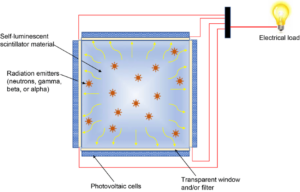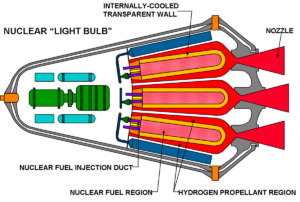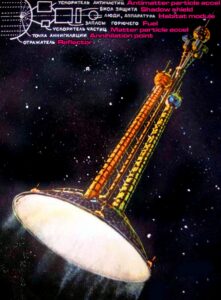In this article nuclear energy to light energy conversion with detailed explanations is going to be illustrated.
Basically conversion of nuclear energy to light energy is an intermediate step of converting nuclear energy to electricity. We can convert nuclear energy to electrical energy by the process of Photon Intermediate Direct Energy Conversion(PIDEC). This process uses fluorescer to generate photons. Fluorescer is used in the form of a gas.
How is nuclear energy converted to Light energy?
In the nuclear fission reaction heavy nuclei get divided into fragments of lighter nuclei. Neutrons are emitted in this reaction. These neutrons are used to excite the fluorescer and as a result narrow band ultraviolet light is emitted.
In this way nuclear energy turns to light energy which in turn is changed to electrical energy by a photovoltaic converter.
As narrow band light energy is produced by PIDEC the released photons are also narrow band photons. So they have more conversion efficiency than the normal solar cells. 40% conversion efficiency can be obtained from PIDEC whereas from nuclear plants only 35% conversion efficiency can be obtained as they have restrictions of nuclear fuel and water as coolants.
The fourth generation nuclear reactors are the best for the PIDEC to be fitted in them. Low pressure liquids can serve the role of fuel as well as coolant. Using these nuclear reactors can be operated in a secured way at very high temperatures which in turn increases the conversion efficiency.

Nuclear energy to light energy examples
23+ nuclear energy to light energy conversion with their details are stated below:
- PIDEC
- The sun
- CFL
- Nuclear light bulbs
- Thermonuclear bomb
- Nuclear warheads
- Nuclear shells
- Nuclear cruise missiles
- Nuclear ship to ship missiles
- Nuclear surface to surface missiles
- Nuclear air to surface missiles
- Nuclear anti ship missiles
- Nuclear ballistic missiles
- Earth penetrating weapon
- Radioactive isotopes
- Nuclear fission fragment rocket
- Nuclear fission sail
- Nuclear fusion rocket
- Gas core reactor rocket
- Nuclear salt water rocket
- Radioisotope rocket
- Nuclear photonic rocket
- Nuclear electric rocket
PIDEC
In this process nuclear fission reactions are the source of generation of neutrons which in turn excite fluorescer and emit narrow band photons.
The sun
The energy conversion is based on the nuclear fusion reaction in the case of the sun. At extreme high temperature and pressure the nuclei of the core get separated from the electrons. Helium atoms are formed from hydrogen nuclei through fusion. During this process light energy is released.
This is the most important example of nuclear energy to light energy conversion.
CFL
Compact Fluorescent Lamp is one of the most important examples of nuclear energy to light energy conversion. In it electrons that are attached to mercury atoms get excited and release photons in the form of ultraviolet light. After that when they return to the lower energy states they convert this ultraviolet light into visible light.

Nuclear light bulbs
A gaseous fission reactor is used in this type of engine so that nuclear propulsion can be achieved.

Thermonuclear bomb
In the explosion caused by this type of bomb nuclear energy to light energy conversion occurs.
Nuclear warheads
In this weapon also nuclear energy to light energy as well as thermal energy conversion takes place.
Nuclear shells
A cannon delivers nuclear shells associated with nuclear artillery. This is another example of nuclear energy to light energy conversion.
Nuclear cruise missiles
Nuclear warheads are usually carried by them. They have a short range and a lighter payload than the ballistic missiles.
Nuclear ship to ship missiles
This is a very important example of nuclear energy to light energy conversion.
Nuclear surface to surface missiles
These types of missiles used to carry nuclear warheads. They always have a range greater than 5500 km.
Nuclear air to surface missiles
They are used to be thrown from the military aircraft to the targets on lands or seas.
Nuclear anti ship missiles
Nuclear energy to light energy as well as thermal energy conversion takes place in these types of missiles.
Nuclear ballistic missiles
A ballistic trajectory is followed by it so that payload can be delivered to the target. Nuclear munitions and high explosives can be carried by them. So this is another notable example of nuclear energy to light energy.
Earth penetrating weapon
It is used for underground explosions. Usually underground military bunkers are destroyed by these nuclear weapons. Nuclear energy is converted to light energy as well as thermal energy through the underground explosions.
Radioactive isotopes
The decay of these elements produce thermal energy and light energy. This is an important example of nuclear energy to light energy conversion.
Nuclear fission fragment rocket
Very high specific impulse can be generated through using this fission fragment rocket. By-products produced by nuclear fission are used to produce thrust.
Nuclear fission sail
It is a spacecraft just like a solar sail. Fission fragments are used to propel it.
Nuclear fusion rocket
This type of rocket does not need a large fuel supply. This is based on fusion propulsion that produces effective acceleration of the rocket in space.

Gas core reactor rocket
Exhausted coolant of a gaseous fission reactor is used to propel these types of reactors. This nuclear reactor has a core of gas or plasma.
Nuclear salt water rocket
In this type of a rocket plutonium salts or 20% uranium salts are used. This salt solution generates thrust in this rocket. Here also nuclear energy is first changed into thermal energy,then mechanical energy(thrust) and a small part of it is changed to light energy.
Radioisotope rocket
This type of a rocket is also an example of nuclear energy to light energy. This is based on the decay of radioisotope elements. Due to the decay of such elements thermal energy is generated which in turn produces thrust that is the mechanical energy to move the rocket upwards. A small amount of thermal energy is converted into light energy.
Nuclear photonic rocket
In this type of a rocket nuclear energy is also converted to light energy. In this high temperatures are produced which in turn emit blackbody radiation from the reactor. This blackbody radiation generates thrust.

Nuclear electric rocket
It is a spacecraft propulsion system. Usually a nuclear reactor is used in its engine to convert nuclear energy to thermal energy. This thermal energy then is converted to a significant amount of electricity and the rest thermal energy is changed into light energy.
Click to read more on Nuclear Energy To Chemical Energy or Nuclear Energy To Sound Energy.
Also Read:
- Example of radiant energy to electrical energy
- Kinetic energy to thermal energy
- How to find energy in a cosmic ray observatory
- How to calculate energy in nonlinear optical materials
- How to calculate free energy in lammps
- How to find energy stored in a dielectric medium
- Hydroelectric energy examples
- Why does energy diverge in ultraviolet catastrophe
- Why is energy balance important in climate modeling
- How to design nuclear energy based medical diagnostic tools
Hi…I am Ankita Biswas. I have done my B.Sc in physics Honours and my M.Sc in Electronics. Currently, I am working as a Physics teacher in a Higher Secondary School. I am very enthusiastic about the high-energy physics field. I love to write complicated physics concepts in understandable and simple words.